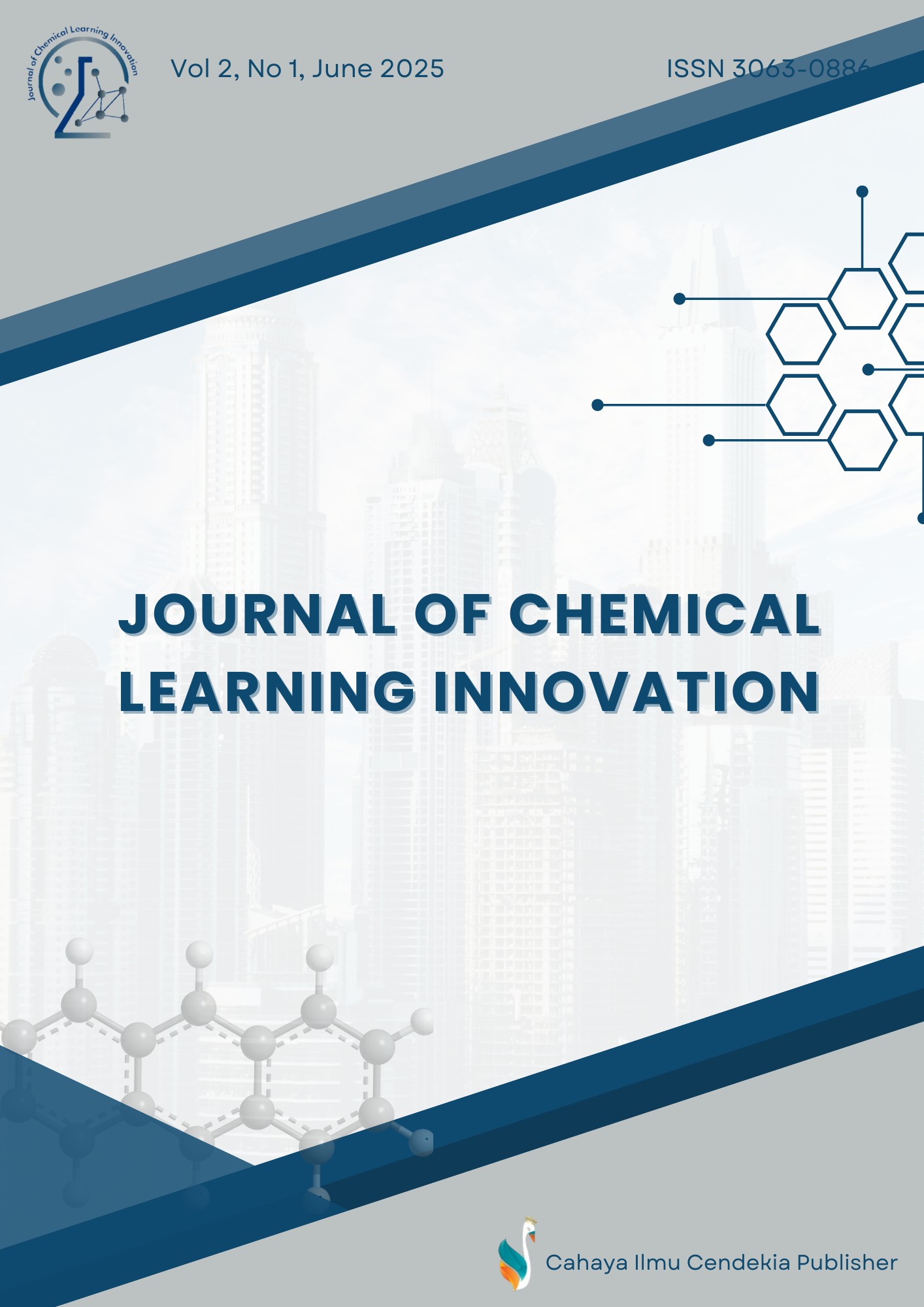Safety First? Exploring Occupational Health and Safety Knowledge Levels of Chemistry Education Students in Laboratory Settings
Abstract
Purpose of the study: The main objective of this study is to identify students' knowledge of Occupational Safety and Security.
Methodology: One hundred and eighty three (183) students of the Chemistry Education study program, Faculty of Tarbiyah and Teacher Training, Syarif Hidayatullah State Islamic University, Jakarta, participated in answering the test on Occupational Safety and Security. This test was developed based on three Occupational Safety and Security indicators, namely storing, general work procedures (handling), and disposal of hazardous chemicals.
Main Findings: Based on data analysis, it was found that on average students have insufficient knowledge about the three Occupational Safety and Security indicators (38%). In detail, the indicator for storing is 33%, general work procedures is 34%, and the last is for disposing of hazardous chemicals is 47%. The results obtained have not been able to show students' general knowledge about Occupational Safety and Security, but can be an early warning to realize the importance of Occupational Safety and Security knowledge for students when experimenting in a chemistry laboratory.
Novelty/Originality of this study: This study examines the level of knowledge of Chemistry Education students regarding the principles of (Occupational Safety and Security) in the laboratory, which is an innovative step in increasing awareness and implementation of safety protocols in practical learning.
References
S. Nardi, M. Schiavon, and O. Francioso, “Chemical structure and biological activity of humic substances define their role as plant growth promoters,” Molecules, vol. 26, no. 8, pp. 1–20, 2021, doi: 10.3390/molecules26082256.
P. A. Yudaev and E. M. Chistyakov, “Progress in dental materials: application of natural ingredients,” Russ. Chem. Rev., vol. 93, no. 3, p. RCR5108, 2024, doi: 10.59761/rcr5108.
P. Reiser et al., “Graph neural networks for materials science and chemistry,” Commun. Mater., vol. 3, no. 1, pp. 1–18, 2022, doi: 10.1038/s43246-022-00315-6.
V. G. Zuin, I. Eilks, M. Elschami, and K. Kümmerer, “Education in green chemistry and in sustainable chemistry: perspectives towards sustainability,” Green Chem., vol. 23, no. 4, pp. 1594–1608, 2021, doi: 10.1039/d0gc03313h.
L. Archer et al., “Reasons for not/choosing chemistry: Why advanced level chemistry students in England do/not pursue chemistry undergraduate degrees,” J. Res. Sci. Teach., vol. 60, no. 5, pp. 978–1013, 2023, doi: 10.1002/tea.21822.
S. Amaliyah, S. Suryaningsih, and L. Yunita, “Gender Differences in the Relationship Between Anxiety, Self-Efficacy and Students Learning Outcomes on Chemistry Subject,” Edusains, vol. 13, no. 1, pp. 8–14, 2021, doi: 10.15408/es.v13i1.12991.
A. Iyamuremye, E. Nsabayezu, C. Ngendabanga, and F. Hagenimana, “the Creative Commons Attributions License [CC BY-NC-ND 4.0] Effectiveness of Hands-on Practical Activities in Teaching and Learning Chemistry: An Exploration of Students’ Engagement, Experience, and Academic Performance,” African J. Educ. Stud. Math. Sci., vol. 19, no. 1, pp. 97–107, 2023, [Online]. Available: http://creativecommons.org/licenses/by-nc-nd/4.0.DOI:https://dx.doi.org/10.4314/ajesms.v19i1.7
J. Yao, “Exploring Experiential Learning: Enhancing Secondary School Chemistry Education Through Practical Engagement and Innovation,” J. Educ. Humanit. Soc. Sci., vol. 22, pp. 475–484, 2023, doi: 10.54097/ehss.v22i.12508.
C. Yeerum et al., “Lab-at-Home: Hands-On Green Analytical Chemistry Laboratory for New Normal Experimentation,” Sustain., vol. 14, no. 6, pp. 1–19, 2022, doi: 10.3390/su14063314.
F. O. Ansah, H. D. Assem, T. A. Ossei-anto, A. Acheampong, and M. Owusu, “Evaluating the Availability and Effectiveness of Safety Equipment in Chemistry Laboratories at Public Colleges of Education in Ghana,” Creat. Educ., vol. 15, pp. 2224–2257, 2024, doi: 10.4236/ce.2024.1510136.
I. I. Salame and J. Makki, “Examining the Use of PhET Simulations on Students’ Attitudes and Learning in General Chemistry II,” Interdiscip. J. Environ. Sci. Educ., vol. 17, no. 4, p. e2247, 2021, doi: 10.21601/ijese/10966.
C. J. Taylor et al., “A Brief Introduction to Chemical Reaction Optimization,” Chem. Rev., vol. 123, no. 6, pp. 3089–3126, 2023, doi: 10.1021/acs.chemrev.2c00798.
W. K. Chiu, “Pedagogy of emerging technologies in chemical education during the era of digitalization and artificial intelligence: a systematic review,” Educ. Sci., vol. 11, no. 11, pp. 1–24, 2021, doi: 10.3390/educsci11110709.
W. Wang, Y. Su, H. Cao, and D. Li, “Enhancing Chemical Laboratory Safety with Hazards Risks Mitigation and Strategic Actions,” Laboratories, vol. 2, no. 5, pp. 1–13, 2025.
S. L. Sonawane, V. J. Patil, and R. A. Tigaa, “Evaluating and Promoting Chemical Safety Awareness in the Chemical Sciences,” J. Chem. Educ., vol. 100, no. 2, pp. 469–478, 2023, doi: 10.1021/acs.jchemed.2c00102.
E. S. Chiwande, V. Shinde, and V. Gudhe, “Assessment of Awareness about Occupational Safety among Laboratory Staff in Healthcare Settings: A Study Protocol,” J. Pharm. Res. Int., vol. 33, no. 64A, pp. 262–267, 2021, doi: 10.9734/jpri/2021/v33i64a35365.
L. Wang, “Strategies for Vocational Chemistry Teaching Based on the STSE Educational Concept,” Int. J. New Dev. Educ., vol. 6, no. 11, pp. 140–145, 2024, doi: 10.25236/IJNDE.2024.061122.
G. Shwartz, O. Shav-Artza, and Y. J. Dori, “Choosing Chemistry at Different Education and Career Stages: Chemists, Chemical Engineers, and Teachers,” J. Sci. Educ. Technol., vol. 30, no. 5, pp. 692–705, 2021, doi: 10.1007/s10956-021-09912-5.
S. R. Goode, J. E. Wissinger, and F. Wood-Black, “Introducing the Journal of Chemical Education’s Special Issue on Chemical Safety Education: Methods, Culture, and Green Chemistry,” J. Chem. Educ., vol. 98, no. 1, pp. 1–6, 2021, doi: 10.1021/acs.jchemed.0c01459.
Fitrijaningsih, D. Purnamawati, T. Srisantyorini, A. Baktiasyah, and A. Triyono, “Implementation of Occupational Safety and Health Management System in the Education Sector,” Indones. J. Occup. Saf. Heal., vol. 12, no. 3, pp. 363–371, 2023, doi: 10.20473/ijosh.v12i3.2023.363-371.
P. Chinwe et al., “SAFETY AND SECURITY IN MANAGING SCHOOL FACILITIES,” Unizik J. Educ. Laws Leadersh. Stud., vol. 1, no. 1, pp. 191–200, 2025.
F. Fatemi, A. Dehdashti, and M. Jannati, “Implementation of Chemical Health, Safety, and Environmental Risk Assessment in Laboratories: A Case-Series Study,” Front. Public Heal., vol. 10, no. June, pp. 1–9, 2022, doi: 10.3389/fpubh.2022.898826.
A. Bowolaksono, F. Lestari, S. A. Satyawardhani, A. Kadir, C. F. Maharani, and D. Paramitasari, “Analysis of bio-risk management system implementation in indonesian higher education laboratory,” Int. J. Environ. Res. Public Health, vol. 18, no. 10, pp. 1–14, 2021, doi: 10.3390/ijerph18105076.
I. P. Adamopoulos and N. F. Syrou, “Workplace Safety and Occupational Health Job Risks Hazards in Public Health Sector in Greece,” Eur. J. Environ. Public Heal., vol. 6, no. 2, pp. 1–13, 2022, doi: 10.21601/ejeph/12229.
S. Kavouras, I. Vardopoulos, R. Mitoula, A. A. Zorpas, and P. Kaldis, “Occupational Health and Safety Scope Significance in Achieving Sustainability,” Sustain., vol. 14, no. 4, pp. 1–17, 2022, doi: 10.3390/su14042424.
Y. Alhammadi, A. M. Farouk, and R. A. Rahman, “Enhancing Construction Safety Education: Insights from Student Perspectives,” Buildings, vol. 14, no. 3, pp. 1–18, 2024, doi: 10.3390/buildings14030660.
A. Pauliková, Z. G. Babel’ová, and M. Ubárová, “Analysis of the impact of human–cobot collaborative manufacturing implementation on the occupational health and safety and the quality requirements,” Int. J. Environ. Res. Public Health, vol. 18, no. 4, pp. 1–15, 2021, doi: 10.3390/ijerph18041927.
I. K. Sudiana and I. W. Suja, “Basic Chemistry Practicum Handbook with Occupational Health and Safety (K3) to Prevent Work Accidents in Laboratory: Validity and Feasibility,” J. Pendidik. dan Pengajaran, vol. 54, no. 1, p. 181, 2021, doi: 10.23887/jpp.v54i1.31934.
A. I. Samaranayake, S. Nishadya, and U. K. Jayasundara, “Analyzing Safety Culture in Sri Lankan Industrial Chemical Laboratories,” Saf. Health Work, vol. 13, no. 1, pp. 86–92, 2022, doi: 10.1016/j.shaw.2021.11.001.
Z. F. Olcay, S. Temur, and A. E. Sakalli, “A research on the knowledge level and safety culture of students taking occupational health and safety course,” Cypriot J. Educ., vol. 16, no. 1, pp. 187–200, 2021, doi: 10.18844/cjes.v16i1.5519.
Z. Hussain, M. A. Burhanuddin, and A. G. Khanapi, “Measure of awareness on occupational health and safety vulnerability in technical and vocational education and training institutions,” Turkish J. Comput. Math. Educ., vol. 12, no. 9, pp. 1093–1103, 2021.
J. Guzman, G. A. Recoco, A. W. Pandi, J. M. Padrones, and J. J. Ignacio, “Evaluating workplace safety in the oil and gas industry during the COVID-19 pandemic using occupational health and safety Vulnerability Measure and partial least square Structural Equation Modelling,” Clean. Eng. Technol., vol. 6, p. 100378, 2022, doi: 10.1016/j.clet.2021.100378.
A. Amelia, A. Rahman, Nursiah, N. Sitorus, B. Viyata Sundawa, and Roslina, “The importance of safety learning to increase student awareness when working in laboratories in vocational education institutions,” in Journal of Physics: Conference Series, 2021, pp. 1–7. doi: 10.1088/1742-6596/1830/1/012002.
A. Aliyo and A. Edin, “Assessment of Safety Requirements and Their Practices Among Teaching Laboratories of Health Institutes,” Microbiol. Insights, vol. 16, p. 117863612311744, 2023, doi: 10.1177/11786361231174414.
W. Alshammari, H. Alhussain, and N. M. Rizk, “Risk management assessments and recommendations among students, staffs, and health care workers in educational biomedical laboratories,” Risk Manag. Healthc. Policy, vol. 14, pp. 185–198, 2021, doi: 10.2147/RMHP.S278162.
L. L. Mugivhisa, K. Baloyi, and J. Oluwole Olowoyo, “Adherence to safety practices and risks associated with toxic chemicals in the research and postgraduate laboratories at Sefako Makgatho Health Sciences University, Pretoria, South Africa,” African J. Sci. Technol. Innov. Dev., vol. 13, no. 6, pp. 747–756, 2021, doi: 10.1080/20421338.2020.1797269.
I. M. Nasrallah, A. K. El Kak, L. A. Ismaiil, R. R. Nasr, and W. T. Bawab, “Prevalence of Accident Occurrence Among Scientific Laboratory Workers of the Public University in Lebanon and the Impact of Safety Measures,” Saf. Health Work, vol. 13, no. 2, pp. 155–162, 2022, doi: 10.1016/j.shaw.2022.02.001.
A. Ghanad, “An Overview of Quantitative Research Methods,” Int. J. Multidiscip. Res. Anal., vol. 06, no. 08, pp. 3794–3803, 2023, doi: 10.47191/ijmra/v6-i8-52.
F. Mulisa, “When Does a Researcher Choose a Quantitative, Qualitative, or Mixed Research Approach?,” Interchange, vol. 53, no. 1, pp. 113–131, 2022, doi: 10.1007/s10780-021-09447-z.
F. D. Lutfiani and A. E. Andriani, “Development of Interactive E-Books Based on Problem-Based Learning on the Material of the Earth ’ s Surface Layers,” J. Pijar MIPA, vol. 20, no. 1, pp. 52–58, 2025, doi: 10.29303/jpm.v20i1.8196.
A. Hamid and S. Wahyuni, “Using blended learning with the help of google classroom and whatsapp in learning of solid substance physics,” Edu Sains J. Pendidik. Sains dan Mat., vol. 11, no. 2, pp. 161–168, 2023.
Copyright (c) 2025 Agia Ghalby, Lloyd Arvin Malaluan

This work is licensed under a Creative Commons Attribution 4.0 International License.
Authors who publish with this journal agree to the following terms:
- Authors retain copyright and acknowledge that the Journal of Chemical Learning Innovation is the first publisher licensed under a Creative Commons Attribution 4.0 International License.
- Authors are able to enter into separate, additional contractual arrangements for the non-exclusive distribution of the journal's published version of the work (e.g., post it to an institutional repository or publish it in a book), with an acknowledgment of its initial publication in this journal.
- Authors are permitted and encouraged to post their work online (e.g., in institutional repositories or on their website) prior to and during the submission process, as it can lead to productive exchanges and earlier and greater citation of published work.





.png)
.png)










